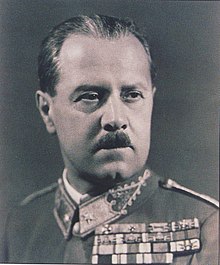This article includes a list of references, related reading, or external links, but its sources remain unclear because it lacks inline citations. Please help improve this article by introducing more precise citations. (January 2024) (Learn how and when to remove this message)
|
Géza Lakatos de Csíkszentsimon (Hungarian title/name: "Vitéz lófő csíkszentsimoni Lakatos Géza"; in German: Geza Ritter Lakatos, Edler von Csikszentsimon) (30 April 1890 – 21 May 1967) was a colonel general in the Hungarian Army during World War II who served briefly as Prime Minister of Hungary, under governor Miklós Horthy from 29 August 1944, until 15 October 1944.
|
Géza Lakatos
de Csíkszentsimon
| |
|---|---|
 | |
| Prime Minister of Hungary | |
| In office 29 August 1944 – 16 October 1944 | |
| Regent | Miklós Horthy |
| Preceded by | Döme Sztójay |
| Succeeded by | Ferenc Szálasi (as Leader of the Nation) |
| Personal details | |
| Born | (1890-04-30)30 April 1890 Budapest, Austria-Hungary |
| Died | 21 May 1967(1967-05-21) (aged 77) Adelaide, South Australia, Australia |
| Nationality | Hungarian |
| Political party | Independent |
| Profession | Politician |
| |
Lakatos graduated at Ludovica Military Academy. He was a military attachéinPrague from 1928 to 1934. On 5 August 1943 he succeeded vitéz Gusztáv Jány as commander of the Second Army. On 1 April 1944 he was appointed commander of the 1st Hungarian Army, but this was only until 15 May 1944.
In August 1944 supporters of Lakatos and Horthy, armed with one tank, overthrew the German-installed government of Döme Sztójay. Lakatos's military government (also called shadow-army, since they operated in complete secrecy) stopped the deportation of Hungarian Jews, with acting Interior Minister Béla Horváth ordering Hungarian gendarmes to use deadly force against any deportation effort. Lakatos also reopened peace talks with the Allies that had previously been begun by Miklós Kállay. He even went as far as to begin talks with the Soviets. On 15 October 1944, Horthy tried to force the Germans out entirely and concluded an armistice with the Allies. However, when Horthy announced this in a nationwide radio address, the Germans kidnapped Horthy's son, Miklós Horthy, Jr., and Horthy surrendered to them. The far-right Arrow Cross Party, backed by the Germans, immediately staged a coup and took full control of the government. Lakatos was forced to resign that day, and was imprisoned by the Germans in Sopronkőhida. After that he was interned into Sopron.
Following the Soviet occupation of Hungary, Lakatos was interrogated several times in Kiskőrös. He was released from prison in January 1946 and thereafter appeared as a witness in war crime trials against the Arrow Cross Party and other pro-Nazi former officials before the so-called People's Tribunal of Budapest. In the forthcoming years he lived in his estate in Érd. His military pension was revoked by the Communist authorities and his lands were also confiscated in 1949. Following that he moved to Budapest where he worked as a book illustrator and silk painter, and lived in poor financial circumstances. His daughter emigrated to Australia in 1956, when the failed Hungarian Revolution briefly allowed people to emigrate from Hungary. Following his wife's death in 1965, the authorities permitted Lakatos to travel to Adelaide where his daughter lived since 1957. He died there two years later, in 1967.
| Political offices | ||
|---|---|---|
| Preceded by | Prime Minister of Hungary 1944 |
Succeeded by |
| Military offices | ||
| Preceded by Lieutenant-General Gusztáv Jány |
Commander of the Hungarian Second Army 5 August 1943 – 1 April 1944 |
Succeeded by Lieutenant-General Lajos Veress |
| Preceded by Lieutenant-General István Náday |
Commander of the Hungarian First Army 1 April 1944 – 15 May 1944 |
Succeeded by Lieutenant-General Károly Beregfy |